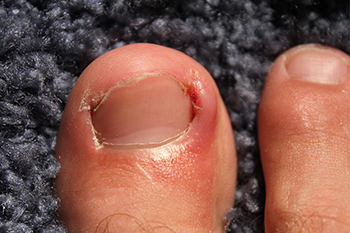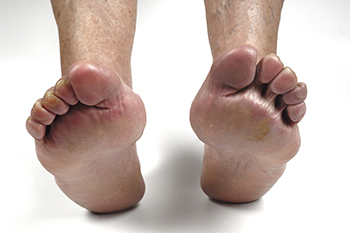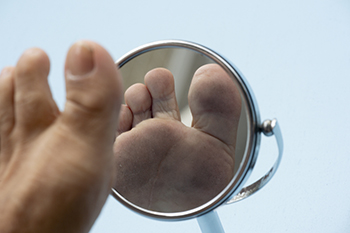Items filtered by date: March 2024
Signs of an Ingrown Toenail
 An ingrown toenail, a common yet uncomfortable condition, occurs when the edge of a toenail grows into the surrounding skin. This often happens on the big toenail. Typical signs include redness and swelling around the affected area, and pain and tenderness when pressure is applied to the toe. More severe cases may involve an infection, which is often indicated by pus or fluid buildup. Some people might also notice the skin next to the nail becoming harder or the nail itself appearing overly curved or thickened. These symptoms not only cause discomfort but can also restrict footwear choices and make walking or standing painful. Recognizing these signs early is important for seeking appropriate treatment to prevent the condition from worsening and to alleviate the discomfort it causes. If you are suffering from an ingrown toenail, it is suggested you make an appointment with a podiatrist, a foot doctor who can effectively treat this condition.
An ingrown toenail, a common yet uncomfortable condition, occurs when the edge of a toenail grows into the surrounding skin. This often happens on the big toenail. Typical signs include redness and swelling around the affected area, and pain and tenderness when pressure is applied to the toe. More severe cases may involve an infection, which is often indicated by pus or fluid buildup. Some people might also notice the skin next to the nail becoming harder or the nail itself appearing overly curved or thickened. These symptoms not only cause discomfort but can also restrict footwear choices and make walking or standing painful. Recognizing these signs early is important for seeking appropriate treatment to prevent the condition from worsening and to alleviate the discomfort it causes. If you are suffering from an ingrown toenail, it is suggested you make an appointment with a podiatrist, a foot doctor who can effectively treat this condition.
Ingrown toenails can become painful if they are not treated properly. For more information about ingrown toenails, contact one of our podiatrists of Centers for Foot & Ankle Care. Our doctors can provide the care you need to keep you pain-free and on your feet.
Ingrown Toenails
Ingrown toenails occur when a toenail grows sideways into the bed of the nail, causing pain, swelling, and possibly infection.
Causes
- Bacterial infections
- Improper nail cutting such as cutting it too short or not straight across
- Trauma to the toe, such as stubbing, which causes the nail to grow back irregularly
- Ill-fitting shoes that bunch the toes too close together
- Genetic predisposition
Prevention
Because ingrown toenails are not something found outside of shoe-wearing cultures, going barefoot as often as possible will decrease the likeliness of developing ingrown toenails. Wearing proper fitting shoes and using proper cutting techniques will also help decrease your risk of developing ingrown toenails.
Treatment
Ingrown toenails are a very treatable foot condition. In minor cases, soaking the affected area in salt or antibacterial soaps will not only help with the ingrown nail itself, but also help prevent any infections from occurring. In more severe cases, surgery is an option. In either case, speaking to your podiatrist about this condition will help you get a better understanding of specific treatment options that are right for you.
If you have any questions please feel free to contact one of our offices located in Merrillville, Portage, Michigan City/LaPorte, and Schererville, IN . We offer the newest diagnostic and treatment technologies for all your foot and ankle needs.
Foot Pain and Rheumatoid Arthritis

Foot pain is often one of the earliest signs of rheumatoid arthritis, or RA, an autoimmune condition affecting joints. RA can manifest in various forms in the feet, including swelling, stiffness, and tenderness. Over time, untreated RA can lead to progressive foot deformities such as bunions, hammertoes, and rheumatoid nodules. Additionally, inflammation in the joints can cause joint erosion and instability, further exacerbating foot problems. Seeking care from a podiatrist is necessary for individuals with RA, as these doctors specialize in managing foot conditions associated with arthritis. Podiatrists can provide comprehensive assessments, including gait analysis and imaging studies, to identify specific foot issues related to RA. If you suffer from RA symptoms in your feet, it is strongly suggested that you are under the care of a podiatrist who can help you maintain mobility and a better quality of life.
Because RA affects more than just your joints, including the joints in your feet and ankles, it is important to seek early diagnosis from your podiatrist if you feel like the pain in your feet might be caused by RA. For more information, contact one of our podiatrists of Centers for Foot & Ankle Care. Our doctors will assist you with all of your podiatric concerns.
What Is Rheumatoid Arthritis?
Rheumatoid Arthritis (RA) is an autoimmune disorder in which the body’s own immune system attacks the membranes surrounding the joints. Inflammation of the lining and eventually the destruction of the joint’s cartilage and bone occur, causing severe pain and immobility.
Rheumatoid Arthritis of the Feet
Although RA usually attacks multiple bones and joints throughout the entire body, almost 90 percent of cases result in pain in the foot or ankle area.
Symptoms
- Swelling and pain in the feet
- Stiffness in the feet
- Pain on the ball or sole of feet
- Joint shift and deformation
Diagnosis
Quick diagnosis of RA in the feet is important so that the podiatrist can treat the area effectively. Your doctor will ask you about your medical history, occupation, and lifestyle to determine the origin of the condition. Rheumatoid Factor tests help to determine if someone is affected by the disease.
If you have any questions please feel free to contact one of our offices located in Merrillville, Portage, Michigan City/LaPorte, and Schererville, IN . We offer the newest diagnostic and treatment technologies for all your foot and ankle needs.
Swollen Feet During Pregnancy

Swelling, or edema, in the feet, is a common occurrence during pregnancy. Swelling of the feet is primarily attributed to hormonal fluctuations, increased blood volume, and fluid retention. The surge in progesterone slows digestion and circulation, leading to fluid accumulation, particularly in the lower extremities. Additionally, the body's heightened blood volume, necessary to support fetal growth and prepare for labor, worsens this swelling. Swelling can begin as early as the fifth month, especially in women exposed to hot climates or extended periods of standing. Taking regular short walks, avoiding prolonged sitting or standing, and opting for comfortable footwear can help alleviate discomfort. Dietary modifications, including potassium-rich foods and reduced sodium intake, may also help manage swelling. If you are troubled by swelling or other foot ailments during pregnancy, it is suggested that you make an appointment with a podiatrist for an exam and treatment options.
Pregnant women with swollen feet can be treated with a variety of different methods that are readily available. For more information about other cures for swollen feet during pregnancy, consult with one of our podiatrists from Centers for Foot & Ankle Care. Our doctors will attend to all of your foot and ankle needs.
What Foot Problems Can Arise During Pregnancy?
One problem that can occur is overpronation, which occurs when the arch of the foot flattens and tends to roll inward. This can cause pain and discomfort in your heels while you’re walking or even just standing up, trying to support your baby.
Another problem is edema, or swelling in the extremities. This often affects the feet during pregnancy but tends to occur in the later stages.
How Can I Keep My Feet Healthy During Pregnancy?
- Wearing orthotics can provide extra support for the feet and help distribute weight evenly
- Minimize the amount of time spent walking barefoot
- Wear shoes with good arch support
- Wear shoes that allow for good circulation to the feet
- Elevate feet if you experience swelling
- Massage your feet
- Get regular, light exercise, such as walking, to promote blood circulation to the feet
If you have any questions please feel free to contact one of our offices located in Merrillville, Portage, Michigan City/LaPorte, and Schererville, IN . We offer the newest diagnostic and treatment technologies for all your foot and ankle needs.
Heel Pain Can Be Treated!
Getting the Right Diagnosis for Diabetic Foot Wounds

Sometimes, it can be tricky when different health issues overlap, such as when a diabetic patient gets foot sores from diabetes, pressure, or both. In such cases, podiatrists need to make sure patients get care that deals with the cause of the sore. For example, a diabetic individual might have a foot sore from pressure or friction, which would likely require different treatment than a foot sore caused by nerve damage or poor circulation. If you have diabetes, it is strongly suggested that you schedule regular appointments with a podiatrist. This foot doctor can routinely examine your feet and administer proper treatment depending on the diagnosis. These types of exams will include checking blood flow, making sure your shoes are not causing foot problems, and caring for wounds as needed.
Wound care is an important part in dealing with diabetes. If you have diabetes and a foot wound or would like more information about wound care for diabetics, consult with one of our podiatrists from Centers for Foot & Ankle Care. Our doctors will assess your condition and provide you with quality foot and ankle treatment.
What Is Wound Care?
Wound care is the practice of taking proper care of a wound. This can range from the smallest to the largest of wounds. While everyone can benefit from proper wound care, it is much more important for diabetics. Diabetics often suffer from poor blood circulation which causes wounds to heal much slower than they would in a non-diabetic.
What Is the Importance of Wound Care?
While it may not seem apparent with small ulcers on the foot, for diabetics, any size ulcer can become infected. Diabetics often also suffer from neuropathy, or nerve loss. This means they might not even feel when they have an ulcer on their foot. If the wound becomes severely infected, amputation may be necessary. Therefore, it is of the upmost importance to properly care for any and all foot wounds.
How to Care for Wounds
The best way to care for foot wounds is to prevent them. For diabetics, this means daily inspections of the feet for any signs of abnormalities or ulcers. It is also recommended to see a podiatrist several times a year for a foot inspection. If you do have an ulcer, run the wound under water to clear dirt from the wound; then apply antibiotic ointment to the wound and cover with a bandage. Bandages should be changed daily and keeping pressure off the wound is smart. It is advised to see a podiatrist, who can keep an eye on it.
If you have any questions, please feel free to contact one of our offices located in Merrillville, Portage, Michigan City/LaPorte, and Schererville, IN . We offer the newest diagnostic and treatment technologies for all your foot care needs.

